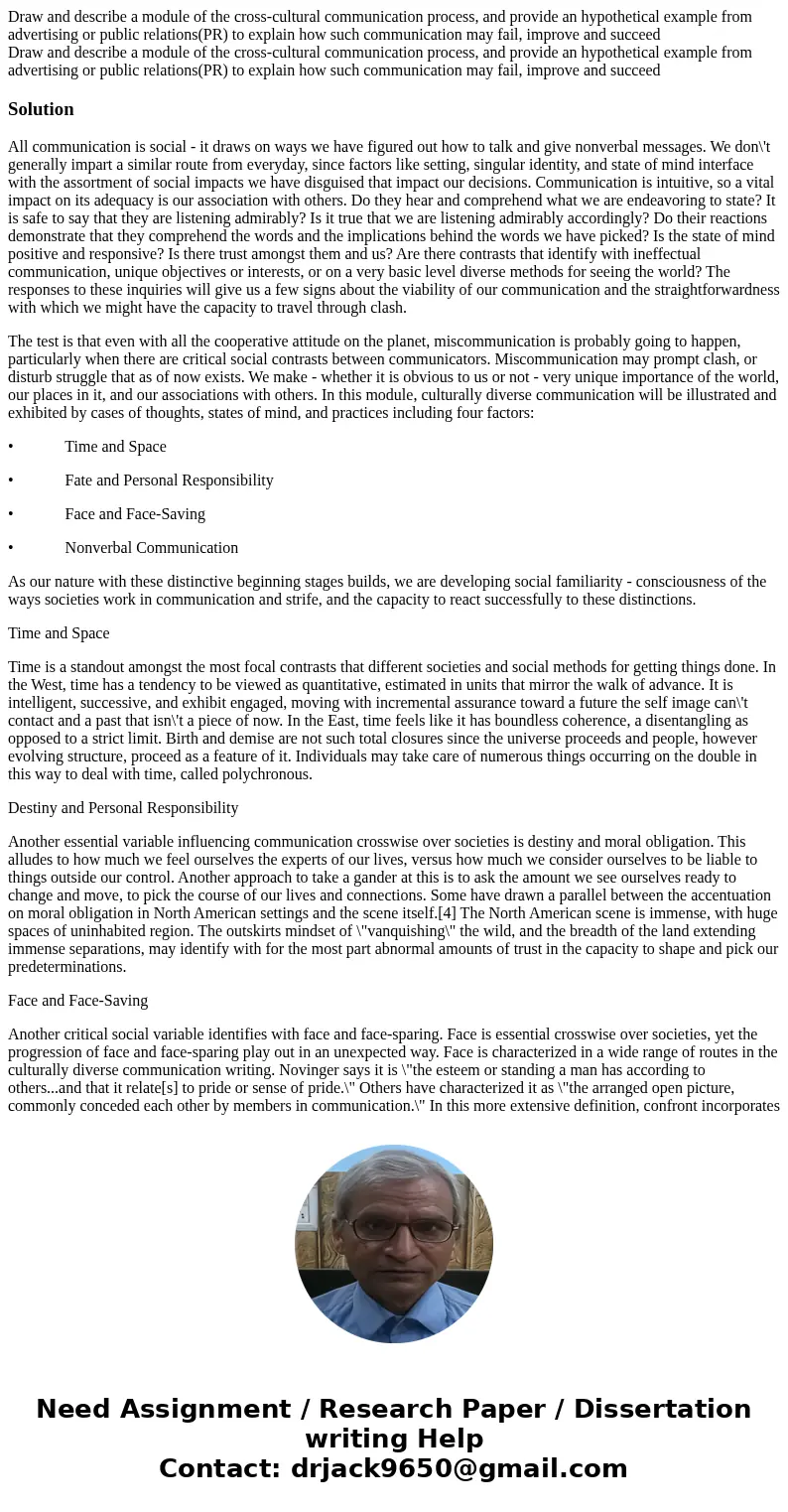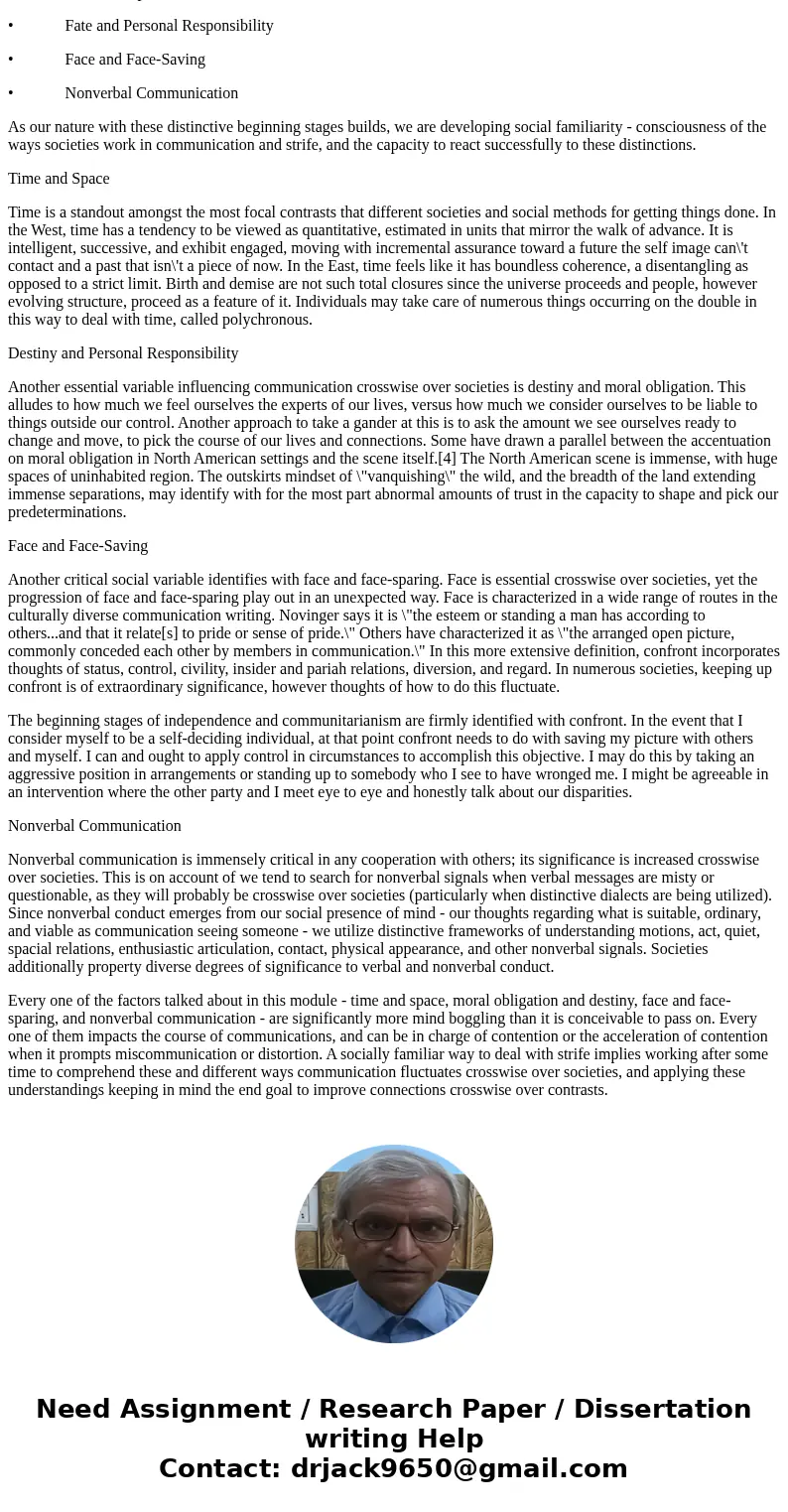Draw and describe a module of the crosscultural communicatio
Solution
All communication is social - it draws on ways we have figured out how to talk and give nonverbal messages. We don\'t generally impart a similar route from everyday, since factors like setting, singular identity, and state of mind interface with the assortment of social impacts we have disguised that impact our decisions. Communication is intuitive, so a vital impact on its adequacy is our association with others. Do they hear and comprehend what we are endeavoring to state? It is safe to say that they are listening admirably? Is it true that we are listening admirably accordingly? Do their reactions demonstrate that they comprehend the words and the implications behind the words we have picked? Is the state of mind positive and responsive? Is there trust amongst them and us? Are there contrasts that identify with ineffectual communication, unique objectives or interests, or on a very basic level diverse methods for seeing the world? The responses to these inquiries will give us a few signs about the viability of our communication and the straightforwardness with which we might have the capacity to travel through clash.
The test is that even with all the cooperative attitude on the planet, miscommunication is probably going to happen, particularly when there are critical social contrasts between communicators. Miscommunication may prompt clash, or disturb struggle that as of now exists. We make - whether it is obvious to us or not - very unique importance of the world, our places in it, and our associations with others. In this module, culturally diverse communication will be illustrated and exhibited by cases of thoughts, states of mind, and practices including four factors:
• Time and Space
• Fate and Personal Responsibility
• Face and Face-Saving
• Nonverbal Communication
As our nature with these distinctive beginning stages builds, we are developing social familiarity - consciousness of the ways societies work in communication and strife, and the capacity to react successfully to these distinctions.
Time and Space
Time is a standout amongst the most focal contrasts that different societies and social methods for getting things done. In the West, time has a tendency to be viewed as quantitative, estimated in units that mirror the walk of advance. It is intelligent, successive, and exhibit engaged, moving with incremental assurance toward a future the self image can\'t contact and a past that isn\'t a piece of now. In the East, time feels like it has boundless coherence, a disentangling as opposed to a strict limit. Birth and demise are not such total closures since the universe proceeds and people, however evolving structure, proceed as a feature of it. Individuals may take care of numerous things occurring on the double in this way to deal with time, called polychronous.
Destiny and Personal Responsibility
Another essential variable influencing communication crosswise over societies is destiny and moral obligation. This alludes to how much we feel ourselves the experts of our lives, versus how much we consider ourselves to be liable to things outside our control. Another approach to take a gander at this is to ask the amount we see ourselves ready to change and move, to pick the course of our lives and connections. Some have drawn a parallel between the accentuation on moral obligation in North American settings and the scene itself.[4] The North American scene is immense, with huge spaces of uninhabited region. The outskirts mindset of \"vanquishing\" the wild, and the breadth of the land extending immense separations, may identify with for the most part abnormal amounts of trust in the capacity to shape and pick our predeterminations.
Face and Face-Saving
Another critical social variable identifies with face and face-sparing. Face is essential crosswise over societies, yet the progression of face and face-sparing play out in an unexpected way. Face is characterized in a wide range of routes in the culturally diverse communication writing. Novinger says it is \"the esteem or standing a man has according to others...and that it relate[s] to pride or sense of pride.\" Others have characterized it as \"the arranged open picture, commonly conceded each other by members in communication.\" In this more extensive definition, confront incorporates thoughts of status, control, civility, insider and pariah relations, diversion, and regard. In numerous societies, keeping up confront is of extraordinary significance, however thoughts of how to do this fluctuate.
The beginning stages of independence and communitarianism are firmly identified with confront. In the event that I consider myself to be a self-deciding individual, at that point confront needs to do with saving my picture with others and myself. I can and ought to apply control in circumstances to accomplish this objective. I may do this by taking an aggressive position in arrangements or standing up to somebody who I see to have wronged me. I might be agreeable in an intervention where the other party and I meet eye to eye and honestly talk about our disparities.
Nonverbal Communication
Nonverbal communication is immensely critical in any cooperation with others; its significance is increased crosswise over societies. This is on account of we tend to search for nonverbal signals when verbal messages are misty or questionable, as they will probably be crosswise over societies (particularly when distinctive dialects are being utilized). Since nonverbal conduct emerges from our social presence of mind - our thoughts regarding what is suitable, ordinary, and viable as communication seeing someone - we utilize distinctive frameworks of understanding motions, act, quiet, spacial relations, enthusiastic articulation, contact, physical appearance, and other nonverbal signals. Societies additionally property diverse degrees of significance to verbal and nonverbal conduct.
Every one of the factors talked about in this module - time and space, moral obligation and destiny, face and face-sparing, and nonverbal communication - are significantly more mind boggling than it is conceivable to pass on. Every one of them impacts the course of communications, and can be in charge of contention or the acceleration of contention when it prompts miscommunication or distortion. A socially familiar way to deal with strife implies working after some time to comprehend these and different ways communication fluctuates crosswise over societies, and applying these understandings keeping in mind the end goal to improve connections crosswise over contrasts.


 Homework Sourse
Homework Sourse